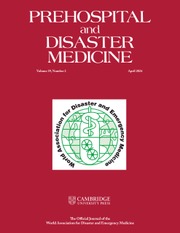No CrossRef data available.
Article contents
Tropical Cyclones and Burn Injuries–Hurricane Ida 2021
Published online by Cambridge University Press: 13 July 2023
Abstract
Tropical cyclones are common weather phenomena occurring during the summer and fall months, primarily impacting coastal areas of the eastern shore of North America and the eastern and southeastern coast of Asia. The injuries often reported in the aftermath of these storms include near drowning, orthopedic injuries, and stress-induced cardiovascular emergencies. However, in the aftermath of Hurricane Ida (August 2021), we saw (and will discuss) an unusual trend of burn injuries.
Anonymized patient data from the regional burn center was reviewed for storm-related injuries in the 30 days post-Hurricane Ida landfall. This retrospective analysis included demographics of the patient population, size of injury (reported in total body surface area [TBSA]), mechanism of injury, and length of stay.
Inclusion criteria (burn injury as a chief complaint during the 30 days following the hurricane) identified 41 patients. Of the 41 patients, (32/41 [78.0%]) were admitted for their injuries. The leading nature of the injuries included flame (25/41 [60.1%) and scald (9/41 [22.0%]). The leading cause of burn injury included generator operations (refueling, gasoline, propane, contact with hot surfaces, etc., (14/41 [34.1%]), debris management (7/41 [17.1%]), and open flame for cooking or lighting (11/41 [26.8%]). Patient ages; median of 43.0 years [0.5 to 79]) with sexual (identity being recorded as) male (32/41 [78.0%]) and (9/41 [22.0%]) female.
Climate change is contributing to the increased frequency and intensity of tropical cyclones. Consequently, strategies such as generator use and reliance on alternative fuel sources for lighting, heating, and cooking, have become more widespread to cope with the temporary interruption of public utilities following a natural disaster. However, these temporary solutions have led to an increased frequency of burn and inhalation injuries. Solutions include campaigns to increase public awareness and an increased clinical readiness to receive and manage more patients with burn and inhalation injuries.
- Type
- Tabletop Presentations
- Information
- Prehospital and Disaster Medicine , Volume 38 , Supplement S1: 22nd Congress on Disaster and Emergency Medicine , May 2023 , pp. s198
- Copyright
- © The Author(s), 2023. Published by Cambridge University Press on behalf of World Association for Disaster and Emergency Medicine





